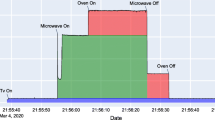Abstract
Improving energy efficiency by monitoring household electrical consumption is of significant importance with the present-day climate change concerns. A solution for the electrical consumption management problem is the use of a non-intrusive load monitoring system (NILM). This system captures the signals from the aggregate consumption, extracts the features from these signals and classifies the extracted features in order to identify the switched on appliances. An effective device identification (ID) requires a signature to be assigned for each appliance. Moreover, to specify an ID for each device, signal processing techniques are needed for extracting the relevant features. This paper describes a technique for the steady-states recognition in an electrical digital signal as the first stage for the implementation of an innovative NILM. Furthermore, the final goal is to develop an intelligent system for the identification of the appliances by automated learning. The proposed approach is based on the ratio value between rectangular areas defined by the signal samples. The computational experiments show the method effectiveness for the accurate steady-states identification in the electrical input signals.
Access this chapter
Tax calculation will be finalised at checkout
Purchases are for personal use only
Preview
Unable to display preview. Download preview PDF.
Similar content being viewed by others
References
Hart, G.W.: Nonintrusive appliance load monitoring. Proceedings of the IEEE, 1870–1891 (1992)
Sultanem, F.: Using appliance signatures for monitoring residential loads at meter panel level. IEEE Transactions on Power Delivery 6, 1380–1385 (1991)
Drenker, S., Kader, A.: Nonintrusive monitoring of electric loads. IEEE Computer Applications in Power 12(4), 47–51 (1999)
Cole, A., Albicki, A.: Data extraction for effective non-intrusive identification of residential power loads. In: Instrumentation and Measurement Technology Conference, vol. 2, pp. 812–815 (1998)
Berges, M., Goldman, E., Matthews, H.S., Soibelman, L.: Learning systems for electric consumption of buildings. In: ASCE International Workshop on Computing in Civil Engineering, Austin, Texas (2009)
Bijker, A.J., Xia, X., Zhang, J.: Active power residential non-intrusive appliance load monitoring system. In: IEEE AFRICON 2009 (2009)
ISA - Intelligent Sensing Anywhere, http://www.isasensing.com/ (last accessed April 15, 2010)
Matthews, H.S., Soibelman, L., Berges, M., Goldman, E.: Automatically disaggregating the total electrical load in residential buildings: a profile of the required solution. In: Intelligent Computing in Engineering (ICE’08) Proceedings, Plymouth (2008)
Cilibrasi, R., Vitányi, P.M.B.: Clustering by compression. IEEE Transactions on Information Theory 51, 1523–1545 (2005)
Author information
Authors and Affiliations
Editor information
Editors and Affiliations
Rights and permissions
Copyright information
© 2010 Springer-Verlag Berlin Heidelberg
About this paper
Cite this paper
Figueiredo, M.B., de Almeida, A., Ribeiro, B., Martins, A. (2010). Extracting Features from an Electrical Signal of a Non-Intrusive Load Monitoring System. In: Fyfe, C., Tino, P., Charles, D., Garcia-Osorio, C., Yin, H. (eds) Intelligent Data Engineering and Automated Learning – IDEAL 2010. IDEAL 2010. Lecture Notes in Computer Science, vol 6283. Springer, Berlin, Heidelberg. https://doi.org/10.1007/978-3-642-15381-5_26
Download citation
DOI: https://doi.org/10.1007/978-3-642-15381-5_26
Publisher Name: Springer, Berlin, Heidelberg
Print ISBN: 978-3-642-15380-8
Online ISBN: 978-3-642-15381-5
eBook Packages: Computer ScienceComputer Science (R0)




